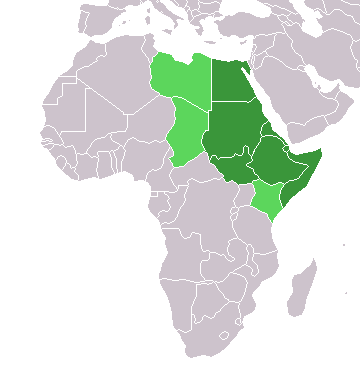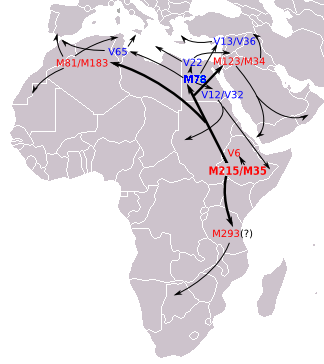|
Haplogroup E1b1b (Y-DNA)
E-M215, also known as E1b1b and formerly E3b, is a major human Y-chromosome DNA haplogroup. It is a division of the macro- haplogroup E-M96, which is defined by the single-nucleotide polymorphism (SNP) mutation M215. In other words, it is one of the major patrilineages of humanity, linking from father-to-son back to a common male-line ancestor ("Y-chromosomal Adam"). It is a subject of discussion and study in genetics as well as genetic genealogy, archaeology, and historical linguistics. The E-M215 haplogroup has two ancient branches that contain all the known modern E-M215, E-M35 and E-M281 subclades. Of the latter two E-M215 subhaplogroups, the only branch that has been confirmed in a native population outside of Ethiopia is E-M35. E-M35 in turn has two known branches, E-V68 and E-Z827, which contain by far the majority of all modern E-M215 subclade bearers. The E-V257 and E-V68 subclades each respectively their highest frequencies in North Africa and the Horn of Africa, an ... [...More Info...] [...Related Items...] OR: [Wikipedia] [Google] [Baidu] |
North Africa
North Africa, or Northern Africa is a region encompassing the northern portion of the African continent. There is no singularly accepted scope for the region, and it is sometimes defined as stretching from the Atlantic shores of Mauritania in the west, to Egypt's Suez Canal. Varying sources limit it to the countries of Algeria, Libya, Morocco, and Tunisia, a region that was known by the French during colonial times as "''Afrique du Nord''" and is known by Arabs as the Maghreb ("West", ''The western part of Arab World''). The United Nations definition includes Morocco, Algeria, Tunisia, Libya, Egypt, Sudan, and the Western Sahara, the territory disputed between Morocco and the Sahrawi Republic. The African Union definition includes the Western Sahara and Mauritania but not Sudan. When used in the term Middle East and North Africa ( MENA), it often refers only to the countries of the Maghreb. North Africa includes the Spanish cities of Ceuta and Melilla, and plazas de so ... [...More Info...] [...Related Items...] OR: [Wikipedia] [Google] [Baidu] |
Haplogroup E-Z827
E-Z827, also known as E1b1b1b, is a major human Y-chromosome DNA haplogroup. It is the parent lineage to the E-Z830 and E-L19 subclades, and defines their common phylogeny. The former is predominantly found in the Middle East; the latter is most frequently observed in North Africa. E-Z827 is also found at lower frequencies in Europe, and in isolated parts of Southeast Africa. Subclades of E-Z827 and Distribution Family Tree The following phylogeny is based on the YCC 2008 tree and subsequent published research as summarized by ISOGG. *E-Z827 (Z827) - E1b1b1bISOGG 2015 **E-V257/L19 (L19, V257) - E1b1b1b1 ***E-PF2431 (PF2431) ****E-PF2438 *****E-Y10561 ******E-FGC18981 *******E-FGC38527 *******E-Y35933 *******E-FGC18960 ********E-Y33020 ********E-FGC18958 *****E-PF2440 ******E-PF2471 *******E-BY9805 ***E-M81 (M81) ****E-M81* ****E-PF2546 *****E-PF2546* *****E-CTS12227 ******E-MZ11 *******E-MZ12 *****E-A929 ******E-Z5009 *******E-Z5009* *******E-Z5010 *******E-Z5013 ********E-Z5 ... [...More Info...] [...Related Items...] OR: [Wikipedia] [Google] [Baidu] |
Pleistocene
The Pleistocene ( , often referred to as the '' Ice age'') is the geological epoch that lasted from about 2,580,000 to 11,700 years ago, spanning the Earth's most recent period of repeated glaciations. Before a change was finally confirmed in 2009 by the International Union of Geological Sciences, the cutoff of the Pleistocene and the preceding Pliocene was regarded as being 1.806 million years Before Present (BP). Publications from earlier years may use either definition of the period. The end of the Pleistocene corresponds with the end of the last glacial period and also with the end of the Paleolithic age used in archaeology. The name is a combination of Ancient Greek grc, label=none, πλεῖστος, pleīstos, most and grc, label=none, καινός, kainós (latinized as ), 'new'. At the end of the preceding Pliocene, the previously isolated North and South American continents were joined by the Isthmus of Panama, causing a faunal interchange between the t ... [...More Info...] [...Related Items...] OR: [Wikipedia] [Google] [Baidu] |
Lengyel Culture
__NOTOC__ The Lengyel culture is an archaeological culture of the European Neolithic, centered on the Middle Danube in Central Europe. It flourished from 5000 to 4000 BC, ending with phase IV, e.g., in Bohemia represented by the ' Jordanow/Jordansmühler culture'. It is followed by the Funnelbeaker/TrB culture and the Baden culture. The eponymous type site is at Lengyel in Tolna county, Hungary. It was preceded by the Linear Pottery culture and succeeded by the Corded Ware culture. In its northern extent, overlapped the somewhat later but otherwise approximately contemporaneous Funnelbeaker culture. Also closely related are the Stroke-ornamented ware and Rössen cultures, adjacent to the north and west, respectively. Subgroups of the Lengyel horizon include the Austrian/Moravian Painted Ware I and II, Aichbühl, Jordanów/Jordanov/Jordansmühl, Schussenried, Gatersleben, etc. It is a wide interaction sphere or cultural horizon rather than an archaeological culture in the n ... [...More Info...] [...Related Items...] OR: [Wikipedia] [Google] [Baidu] |
Sopot Culture
The Sopot culture is a neolithic archaeological culture that was first identified in eastern Slavonia in modern-day Croatia, and was since also found in several sites in Hungary. It was a continuation of the Starčevo culture and strongly influenced by the Vinča culture. Some of the archeological sites where artifacts of it were found include Samatovci, Vinkovci–Sopot, Otok, Privlaka, Vinkovci– Ervenica, Osijek, Bapska, Županja, Klokočevik. It spread into northern Bosnia from its original area to the west to northwestern Croatia and to the north to Hungarian Transdanubia, where it helped Lengyel culture start. The culture dates to around 5000 BC. Settlements were raised on the river banks (most noticeably on the banks of Bosut, around the area of the modern city of Vinkovci). Houses were square and made of wood using interlace technique, sometimes separated into multiple rooms. Artefacts include many weapons made of bone, flint, obsidian, and ironed volcanic rocks an ... [...More Info...] [...Related Items...] OR: [Wikipedia] [Google] [Baidu] |
Neolithic
The Neolithic period, or New Stone Age, is an Old World archaeological period and the final division of the Stone Age. It saw the Neolithic Revolution, a wide-ranging set of developments that appear to have arisen independently in several parts of the world. This "Neolithic package" included the introduction of farming, domestication of animals, and change from a hunter-gatherer lifestyle to one of settlement. It began about 12,000 years ago when farming appeared in the Epipalaeolithic Near East, and later in other parts of the world. The Neolithic lasted in the Near East until the transitional period of the Chalcolithic (Copper Age) from about 6,500 years ago (4500 BC), marked by the development of metallurgy, leading up to the Bronze Age and Iron Age. In other places the Neolithic followed the Mesolithic (Middle Stone Age) and then lasted until later. In Ancient Egypt, the Neolithic lasted until the Protodynastic period, 3150 BC.Karin Sowada and Peter Grave. Egypt in ... [...More Info...] [...Related Items...] OR: [Wikipedia] [Google] [Baidu] |
Neolithic Revolution
The Neolithic Revolution, or the (First) Agricultural Revolution, was the wide-scale transition of many human cultures during the Neolithic period from a lifestyle of hunting and gathering to one of agriculture and settlement, making an increasingly large population possible. These settled communities permitted humans to observe and experiment with plants, learning how they grew and developed. This new knowledge led to the domestication of plants into crops. Archaeological data indicates that the domestication of various types of plants and animals happened in separate locations worldwide, starting in the geological epoch of the Holocene 11,700 years ago. It was the world's first historically verifiable revolution in agriculture. The Neolithic Revolution greatly narrowed the diversity of foods available, resulting in a downturn in the quality of human nutrition compared with that obtained previously from foraging. The Neolithic Revolution involved far more than the adop ... [...More Info...] [...Related Items...] OR: [Wikipedia] [Google] [Baidu] |
Near East
The ''Near East''; he, המזרח הקרוב; arc, ܕܢܚܐ ܩܪܒ; fa, خاور نزدیک, Xāvar-e nazdik; tr, Yakın Doğu is a geographical term which roughly encompasses a transcontinental region in Western Asia, that was once the historical Fertile Crescent, and later the Levant region. It also comprises Turkey (both Anatolia and East Thrace) and Egypt (mostly located in North Africa, with the Sinai Peninsula being in Asia). Despite having varying definitions within different academic circles, the term was originally applied to the maximum extent of the Ottoman Empire. According to the National Geographic Society, the terms ''Near East'' and ''Middle East'' denote the same territories and are "generally accepted as comprising the countries of the Arabian Peninsula, Cyprus, Egypt, Iraq, Iran, Israel, Jordan, Lebanon, Palestinian territories, Syria, and Turkey". In 1997, the Food and Agriculture Organization of the United Nations, Food and Agriculture Organization (FAO) ... [...More Info...] [...Related Items...] OR: [Wikipedia] [Google] [Baidu] |
Northeast Africa
Northeast Africa, or ''Northeastern Africa'' or Northern East Africa as it was known in the past, is a geographic regional term used to refer to the countries of Africa situated in and around the Red Sea. The region is intermediate between North Africa and East Africa, and mainly encompasses the Horn of Africa (Ethiopia, Eritrea, Somalia, and Djibouti) and the Sudans and as well as Egypt and Libya. Sometimes, its borders are stretched to either include Kenya like the NFD region or Eastern Chad. The region has a very long history of habitation with fossil finds from the early hominids to modern human and is one of the most genetically and linguistically diverse regions of the world, being the home to many civilizations and located on an important trade route that connects multiple continents.Project MUSE. (2020). Northeast African Studies'. Retrieved March 22, 2020. "This distinguished journal is devoted to the scholarly analysis of Ethiopia, Eritrea, Djibouti, Somalia, and Sudan, ... [...More Info...] [...Related Items...] OR: [Wikipedia] [Google] [Baidu] |
Paraphyly
In taxonomy (general), taxonomy, a group is paraphyletic if it consists of the group's most recent common ancestor, last common ancestor and most of its descendants, excluding a few Monophyly, monophyletic subgroups. The group is said to be paraphyletic ''with respect to'' the excluded subgroups. In contrast, a monophyletic group (a clade) includes a common ancestor and ''all'' of its descendants. The terms are commonly used in phylogenetics (a subfield of biology) and in the tree model of historical linguistics. Paraphyletic groups are identified by a combination of Synapomorphy and apomorphy, synapomorphies and symplesiomorphy, symplesiomorphies. If many subgroups are missing from the named group, it is said to be polyparaphyletic. The term was coined by Willi Hennig to apply to well-known taxa like Reptilia (reptiles) which, as commonly named and traditionally defined, is paraphyletic with respect to mammals and birds. Reptilia contains the last common ancestor of reptiles a ... [...More Info...] [...Related Items...] OR: [Wikipedia] [Google] [Baidu] |
E1b1b Ancestry
E-M215, also known as E1b1b and formerly E3b, is a major human Y-chromosome DNA haplogroup. It is a division of the macro- haplogroup E-M96, which is defined by the single-nucleotide polymorphism (SNP) mutation M215. In other words, it is one of the major patrilineages of humanity, linking from father-to-son back to a common male-line ancestor (" Y-chromosomal Adam"). It is a subject of discussion and study in genetics as well as genetic genealogy, archaeology, and historical linguistics. The E-M215 haplogroup has two ancient branches that contain all the known modern E-M215, E-M35 and E-M281 subclades. Of the latter two E-M215 subhaplogroups, the only branch that has been confirmed in a native population outside of Ethiopia is E-M35. E-M35 in turn has two known branches, E-V68 and E-Z827, which contain by far the majority of all modern E-M215 subclade bearers. The E-V257 and E-V68 subclades each respectively their highest frequencies in North Africa and the Horn of Af ... [...More Info...] [...Related Items...] OR: [Wikipedia] [Google] [Baidu] |







